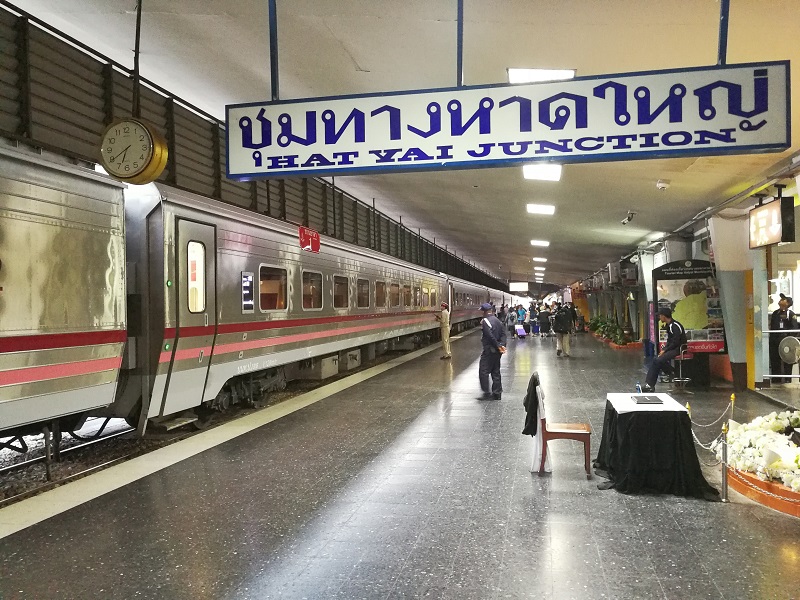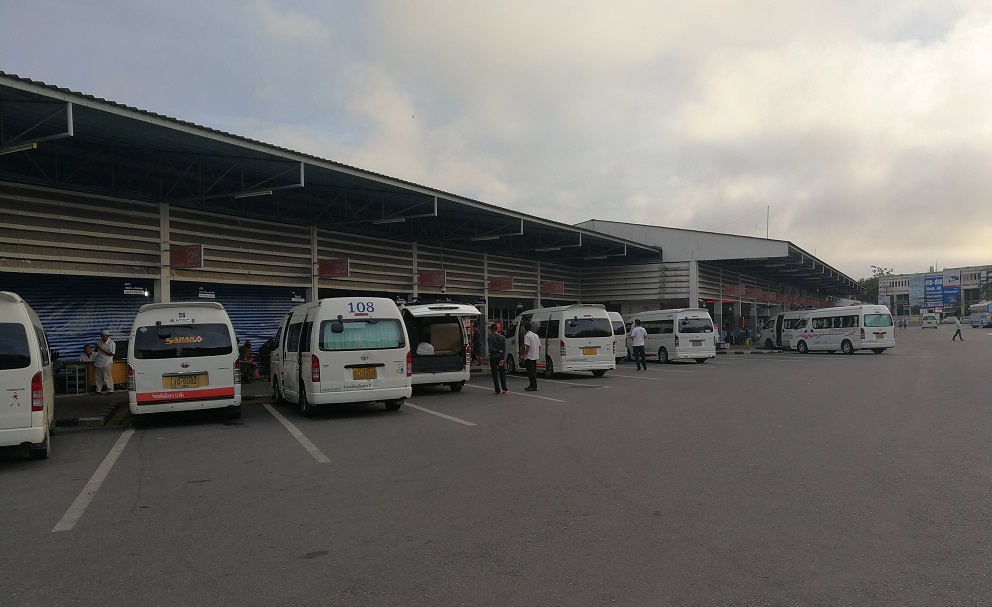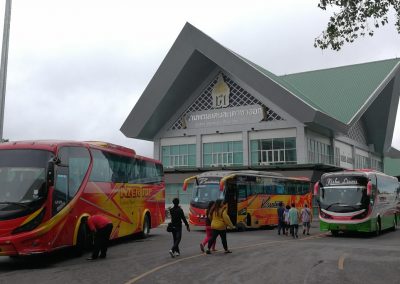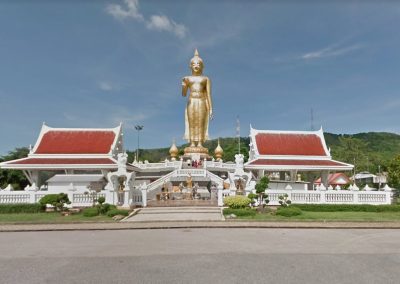HAT YAI
HAT YAI (Haadyai) is the largest metropolitan area in southern Thailand, and the third largest in Thailand. While, it is the 5th largest City Municipality (thesaban nakhon), after Krung Thep (Bangkok), Nonthaburi, Korat (Nakhon Ratchasima) and Chiang Mai, in terms of population.
Hat Yai is the business hub and transportation hub in southern Thailand, also the busiest border town nearest to Malaysia – Bukit Kayu Hitam via Sadao checkpoint. Located along Asian Highway route 2 – AH2, which links Bangkok to Hat Yai, Kuala Lumpur and Singapore.
Sadao (Dannok) checkpoint is the busiest checkpoint for Thailand in terms of Trade Volume and flows of travelers among neighboring countries.
Hat Yai is 936 km south of the the capital – Bangkok, only 532 km in distance from Kuala Lumpur, Malaysia. It is still nearer in distance by road even travelling from Singapore, only 890 km.
Hat Yai Transport
Hat Yai city is the most popular holiday destination in the region, attracts big crowds of holiday goers every holiday occasion from the neighboring countries, especially Malaysia.
Located along AH2 – Asian Highway route 2, it is only 70 minutes or 56 km away from the busiest Thai-Malaysia border checkpoint – Sadao / Bukit Kayu Hitam, where traveling 883 km further south is the southernmost tip of mainland Asia – Tanjung Piai in Johor. Singapore is just across the straits of Johor.
- Sadao / Bukit Kayu Hitam checkpoint is the most popular checkpoint from Malaysia for road travelers, while Padang Besar is the checkpoint for rail travelers as well as alternative checkpoint for road travelers. Follow by Sungai Kolok , Betong, Wang Prachan and Ban Prakop checkpoints. Especially Ban Prakop / Kota Putra checkpoint is getting popularity as an alternative route entering Thailand from Kedah, Malaysia. Which is to avoid congestion at Sadao / Bukit Kayu Hitam during perk seasons. Kota Putra is also known as Durian Burung, derived from the road name Jalan Durian Burung access from Kuala Nerang or Lebuhraya Baling.
- Hat Yai International Airport is the second busiest among domestic routes connecting Don Mueang International Airport in Krung-thep which generally known as Bangkok for non-Thai speaking people. Located in Khlong Hoi Khong District, Songkhla Province. South-western of Hat Yai, only 14 km from the town center.
- Hat Yai Junction railway station is only 500 meters away from the popular Lee Gardens Walking Street, the well known landmark of Lee Gardens Plaza Hotel. The railway station is the hub for southern rail line services, which connects to the two border towns neighboring Malaysia. Namely Padang Besar in Sadao district, Songkhla province and Sungai Kolok in Narathiwat province, the town is called Rantau Panjang across the border in Malaysia.
- Hat Yai Bus Terminal is located at the south-eastern of the city, next to Central Festival Shopping Complex. Minivan service is available at the same location.
- Hat Yai District Transportation Terminal 2, located 5 km away at Petchkasem Road slightly outskirt from the city center. There is pickup service at Terminal 1, near the Central Festival Shopping Complex.
- AH2 connects through the west coast states of Peninsular Malaysia via the 772 km North-south Expressway – NSE / E1, to Johor Bahru and Singapore. Whereas AH18 begins in Hat Yai, via Pattani, Narathiwat road 43 & 42, enters Malaysia through Federal Road 3 of the east coast towns, including Kota Bahru, Kuantan, Mersing to Johor Bahru and through the Johor causeway link to Singapore.
- Documents required to enter Thailand by car
KTM (Malaysia) ETS & SRT (Thailand) Train Service Timetable
KL – Taiping – Butterworth – Padang Besar >> Hat Yai – Bangkok trains
Train no. EG9420 10:41 (KL Sentral) > 14:00 (Taiping) > 16:18 (P.Besar) >>
Special Express Train no.46 16:40 (P.Besar) > 17:25 (Hat Yai) > 08:30 (Krung Thep Aphiwat)
Bangkok – Hat Yai – P.Besar >> Butterworth – Taiping – KL trains
Special Express Train no.45 18:50 (Krung Thep Aphiwat) – 07:25 (Hat Yai) – 08:05 (P.Besar)
Train no. EP9275 09:45 (P.Besar) – 12:01 (Taiping) – 15:10 (KL Sentral)
* Effective 01-Aug-2024
– Check KTM / ETS & Commuter Trains Timetable for more train details
– Thailand – Malaysia Border Checkpoints

Hat Yai Junction (Hat Yai Railway Station), is the main Railway Hub in the south connects trains to Bangkok, and Malaysia border at Sungai Kolok and Padang Besar.

Located adjacent to Hatyai Bus Terminal, Hatyai Minivan Terminal serving most of the destinations in neighboring districts and provinces.

Hatyai International Airport (HDY) is the major airport serving the southern region.
Hat Yai Tourist spot and attractions
Brahma
Brahma is known as Phra Phrom in Thailand, traditionally depicted with four faces and four arms. Each face of his points to a cardinal direction. His hands hold no weapons, rather symbols of knowledge and creation.
-
- In one hand he holds the sacred texts of Vedas
- in the second, he holds mala (rosary beads) symbolizing time
- in the third, he holds a sruva or shruk – ladle types symbolizing means to feed sacrificial fire
- in the fourth, a kamandalu – utensil with water symbolizing the means where all creation emits from
- Brahma is a Hindu god, referred to as “the Creator”
- But, buddhism assumes that the universe has no ultimate beginning to it, and thus posits that Mahabrahma is misconstrued to be a creator.
- Brahma is generally known as Simianfo (四面佛, “Four-Faced Buddha”) among Chinese community
- 梵天 pronounced as Fantian is the Chinese character and Bonten in Japanese Kanji literally referring to Brahma. Whereas, in Tibetan it is called Tshangs pa
- Thai Buddhists worship Brahma alongside Buddhist practices, which is regarded as the deity of good fortune and protection.
- Brahma is usually called Mahabrahma in Thailand, means the Great Brahma, is the ruler of the Brahmaloka / Brahma World in the Buddhist cosmology
In a 16th-century novel, “Journey to the West”, Sun-Wukong takes the monk Tang Sanzang to the heaven of Brahmas to meet Mahabrahma, where the monk impresses the Brahmas with his lecture on the Lotus Sutra. Mahabrahma revered by Buddhists around the world, thus statues of Mahabrahma can be found in many Buddhist temple and business complex.
- Such as Erawan Shrine in Bangkok is one of the well known Phra Phrom shrines in Thailand.
- The Brahma shrine – San Phra Phrom in Hat Yai, is well-known by devotees of Chinese community especially from Malaysia and Singapore, is located on Kho Hong Hill in Hat Yai Municipal Park. It can be reached by cable car from the Golden Standing Buddha, which officially named Phra Phutthamongkol Maharat
- At Jalan Gasing, Petaling Jaya, Malaysia. Wat Chetawan features Brahma in the pavilion before the main prayer hall
- A shrine to Brahma can also be found in Cambodia’s Angkor Wat
- One of the three largest temples in the 9th-century Prambanan temples complex in Yogyakarta, central Java is dedicated to Brahma
- Hindus in Indonesia still have a high regard for Brahma (Batara Brahma or Sanghyang Brahma).
- In Bali there is Andakasa Temple dedicated to Brahma
- The most prominent Hindu temple for Brahma is the Brahma Temple in Pushkar, India. However, not many temples in India are dedicated to Brahma and his main worship
- The former name of the country Myanmar – Burma may be derived from Brahma. In medieval texts, it is referred to as Brahma-desa


Left: Phra Phrom at Kho Hong Hill in Hat Yai Municipal Park. Right: Brahma in Thai Buddhist Temple at Jalan Gasing, Petaling Jaya
Wat Chetawan at Jalan Gasing, Petaling Jaya
Also known as Chetawan Thai Buddhist Temple, established in 1957 and completed construction in 1962, it was officiated by the late King Bhumibol Adulyadej. The temple is also the only Malaysian Siamese temple which has been chosen as the custodian of the Buddha sacred relics for all Malaysian Buddhists that are parts of the ancient relics discovered in Piprahwa, a village near the border of Nepal in 1898
The sacred relics were presented to King Chulalongkorn by the then British Viceroy of India, Lord Curzon – Viceroy of India 1899 ~ 1905
To commemorate the 2,600th anniversary of Buddha’s Enlightenment and to mark King Bhumibol Adulyadej and Queen Sirikit’s 85th and 80th birthday anniversaries respectively, a portion of those sacred relics of Buddha were presented to Wat Chetawan in Malaysia, on 27 June 2012 by senior monk from Bangkok, Somdej Phramaharatch Amangkalajarn as a token of goodwill from Thai Buddhists to Malaysian Buddhists.
The temple is now a place of devotees from both Malaysian & Thais.
Its main prayer hall houses several images of Buddha while the Brahma – Phra Phrom, features in the pavilion before the main prayer hall.
Songkran Festival
Every year on the 13th in April, an important festive season called Songkran or Splashing Water Festival ignites in many places throughout the world.
“Songkran” derives from Sanskrit word, literally means transformation or change. Traditionally, Songkran celebration usually begins with visiting local temples and offering food to Buddhist monks as kind of merit-making. Read more…
Chao Mae Lim Ko Niao Cemetery
Who is Miss Lim (Lim Ko Niao)? Why is it worshiped by people? Some people say that Miss Lim is very magical. She was originally a “ghost”. Because she often appeared and helped many people, she was placed in a temple by the local people and became a local “goddess”.
It turns out that the main reason why local people worship Miss Lim so much is related to the abandoned mosque not far from the temple dedicated to Miss Lim. Read more…
Pedestrian bridge linking Padang Besar Railway Station and ICQS Complex finally reopened
By Aizat Sharif – February 15, 2024
After being closed for almost four years, the pedestrian bridge that links Padang Besar KTM railway station and the Immigration, Customs, Quarantine, and Security (ICQS) Complex has finally reopened.
The 350m pedestrian bridge was closed on Sept 1, 2020 by the Perlis Immigration Department for safety reasons following the series of arrests involving illegal entrance attempts by foreigners.
The temporary closure was also done to make way for the bridge’s corridor upgrading words and the construction of a fenced walkway connecting the pedestrian bridge from the ICQS Complex to the Padang Besar roundabout.
State Infrastructure and Public Transport Committee chairman Izizam Ibrahim said the reopening of the pedestrian bridge was the result of discussion with the Railway Asset Corporation, Keretapi Tanah Melayu Bhd (KTMB) and the Immigration Department.
“After being closed for four years, we have reached an agreement to reopen the pedestrian bridge that was delayed in November for certain reasons, from 6am to 10pm daily.
“With the reopening of the pedestrian bridge, we have resolved two or three issues concerning the ease of the visitors who arrive by train, but we have also identified several matters that need improvement later on.
“This includes the disabled-friendly facility since the pedestrian bridge only has a staircase for now, meaning that disabled persons might have to still use the service of cabs or e-hailing,” he said when met at the State Legislative Assembly building here yesterday.
He said at the same time, the reopening of the pedestrian bridge might have an impact on the taxi and e-hailing drivers who are transporting passengers to the Padang Besar arcade.
“I will be meeting them to find the best solution on the matter and at the same time we need to come up with an alternative to create more activities at the railway station.
“There are a few potential investors who have expressed their interest to develop the railway station’s surrounding area,” he said.
Earlier, Izizam and representatives from the RAC, KTMB and Perlis Immigration Department visited the site.
The fenced walkway, built at a cost of RM250,000 is also equipped with security cameras.
Based Perlis Immigration record, there has been a drop in the arrests of illegal immigrants at the pedestrian bridge between 2018 and 2019.
In 2018, 12 illegal immigrants were arrested and the number was down to six in 2019.
Early Days of Hat Yai
“Hat Yai” is derived from a fruit name called Mahat, probably due to its significant big in size, it is commonly called Mahat Yai, meaning Big Mahat. A short form of Mahat Yai is now called Hat Yai.
During the early days, Hat Yai was just a small community village called Khok Samet Chun, the small village started development and growth in population rapidly after the railway was built in year 1922, and the station become the major hub of the southern line, from Nakhon Si Thammarat to Pattani, junction to Padang Besar.
The junction was originally connected to the town of Songkhla via U-Ta Phao river area, but was later moved to Khok Samet Chun in 1922 because the river area found out to be flood-prone. In year 1928, Hat Yai was became a community, after which it was further upgraded to a Sanitary District in year 1935, covered an area of 4.4 square kilometers. The municipal administration building was completed in 1938, and granted Town status in 1949.
In 1961, the area covered by the municipality was further increased to 8.0 square kilometers, then in 1977, the total area covered by the municipality was again increased to 21 square kilometers. In 1995, the town was upgraded to city status.
Today, Hat Yai is the largest city, also the business center of Songkhla Province. Whereas, Songkhla City is the administrative center of Songkhla Province.
Phra Phrom Mantra/Katha – พระพรหม – 四面佛经
Loy Krathong
Loy Krathong in Thai literally means “to float ritual lamp”, is a Thai festival celebrated annually throughout Thailand and in nearby countries with significant South Western China TAI cultures including Laos, Shan, Mon, Tanintharyi and Xishuangbanna. Read more…
Loy Krathong celebration venues in Hat Yai
Phuket is an island in the Andaman Sea, is one of the southern provinces of Thailand, about double the size of Penang Island, slightly larger than the size of Langkawi. Is the largest island of Thailand. Read more…














